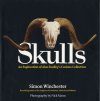About this book
In Skulls: An Exploration of Alan Dudley's Curious Collection, Simon Winchester (author of The Profesor and the Madman, Atlantic: A Biography of the Ocean, Krakatoa: The Day the World Exploded, and others) tells the captivating story of skulls, both human and animal, and of one man who has spent a lifetime obsessively assembling what is the largest and most wide-ranging personal collection of animal skulls in the world.
Alan Dudley, who hails from the English Midlands, has in his possession more than 2000 skulls that he has been collecting, preparing, and cataloging to almost museum quality over the course of more than five decades. He is well known in some circles as an authority on skulls, and his collection is recognized as an excellent reference of great breadth and depth. It is his collection that forms the centerpiece of Skulls: An Exploration of Alan Dudley's Curious Collection and around which Winchester weaves his ever-engaging prose.
He begins with Dudley's own evolution from a young lad drawn to the local wildlife and a collector of birds' eggs and newts to a grown man who learned the skills of taxidermy and the various ways of preparing a skull (and who, in his zeal to acquire the rarest types of skulls, was once arrested and charged with breaching the Convention on Intemational Trade in Endangered Species).
Winchester continues with an enlightening explanation of the skull's component parts – the cranium, the mandible, and the shape and positioning of eye sockets and auditory bullae – followed by a discussion of species-specific features like horns, teeth, beaks, and bills. He then delves into an exploration of the science and pseudo-science of skulls, covering legitimate anthropological discoveries such as Mrs. Ples and Lucy, and the study of the evolution of the human skull, as well as hoaxes such as the Piltdown Man and the practice of phrenology.
Departing from a physical and scientific focus, Winchester also mines the rich tradition of skulls in art, starting from the Middle Ages and the works of Fra Angelico and Leonardo da Vinci and continuing through the present day with the paintings of Georgia O'Keefe and the creations of Steven Gregory and Damien Hirst. He writes about the history of the skull as an icon of death and a symbol of power and warning and discusses the role of skulls in religion, most notably in the Mexican Day of the Dead.
At the heart of Skulls: An Exploration of Alan Dudley's Curious Collection is the extraordinary visual array of never-before-seen images of Dudley's invaluable collection. On display are more than 300 of the most exquisite specimens. From an aardvark to a red-bellied piranha, an African lion to a wrinkled hotnbill, every skull is photographed with stunning clarity, often from several angles to give the most intimate and intriguing view possible. Organized by class, and species, the skulls include explanatory notes highlighting each specimen's most interesting features, as well as additional information on the animal's taxonomy, behavior, and diet.
In Skulls: An Exploration of Alan Dudley's Curious Collection, brilliant storytelling combines with surprisingly beautiful imagery of the endless variety of cranial structures of the animal kingdom. The result, as Winchester says, is "a near-perfect survey [...] designed for browsing, for amusement, for macabre fascination, but, most of all, for learning."
Customer Reviews
Biography
Simon Winchester is the bestselling author of The Surgeon of Crowthorne, Atlantic, The Map that Changed the World, Krakatoa, A Crack in the Edge of the World, The Man Who Loved China, and more than a dozen other books. His work has appeared in The New York Times, The New York Review of Books, National Geographic, Lapham's Quarterly, and elsewhere. Mr. Winchester was made Officer of the Order of the British Empire (OBE) by Elizabeth II in 2006. He lives in New York City and Massachusetts.
Nick Mann is a photographer who specializes in beautiful multi-angle documentation of objects. His work includes The Elements: A Visual Exploration of Every Known Atom in the Universe by Theodore Gray. He is currently based in Urbana, Illinois, and New York City.













![Crânes: 300 Spécimens de la Collection Dudley [Skulls: An Exploration of Alan Dudley's Curious Collection] Crânes: 300 Spécimens de la Collection Dudley [Skulls: An Exploration of Alan Dudley's Curious Collection]](http://mediacdn.nhbs.com/jackets/jackets_resizer/20/209368.jpg)
![Skulls: Die Faszinierende Schädel-Sammlung des Alan Dudley [Skulls: An Exploration of Alan Dudley's Curious Collection] Skulls: Die Faszinierende Schädel-Sammlung des Alan Dudley [Skulls: An Exploration of Alan Dudley's Curious Collection]](http://mediacdn.nhbs.com/jackets/jackets_resizer/22/224592.jpg)










![Kame no Kōra wa Abarabone: Jintai de Arawasu Ugokumonozukan [Turtle Shells Have Ribs: A Picture Book of Animal Anatomy Represented by the Human Body]](http://mediacdn.nhbs.com/jackets/jackets_resizer_medium/24/249897.jpg?height=150&width=99)








